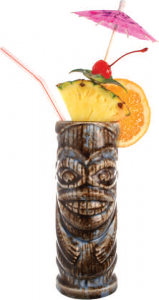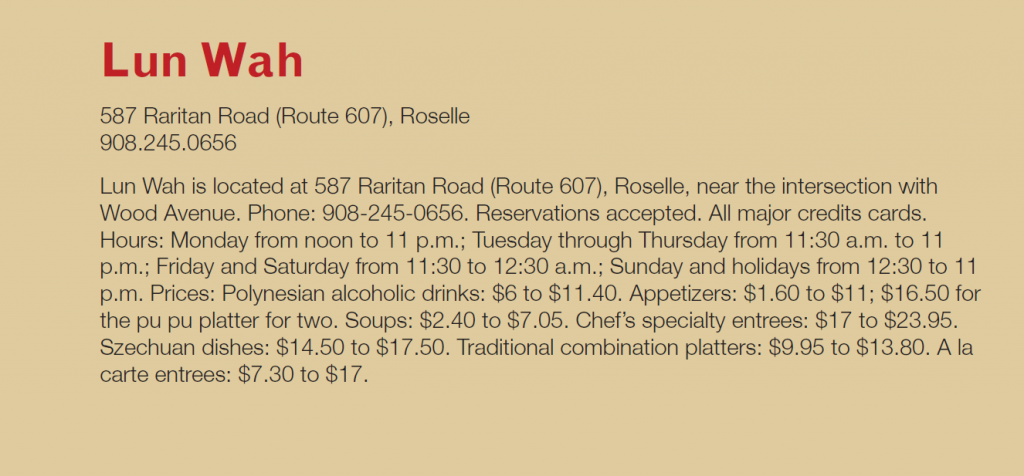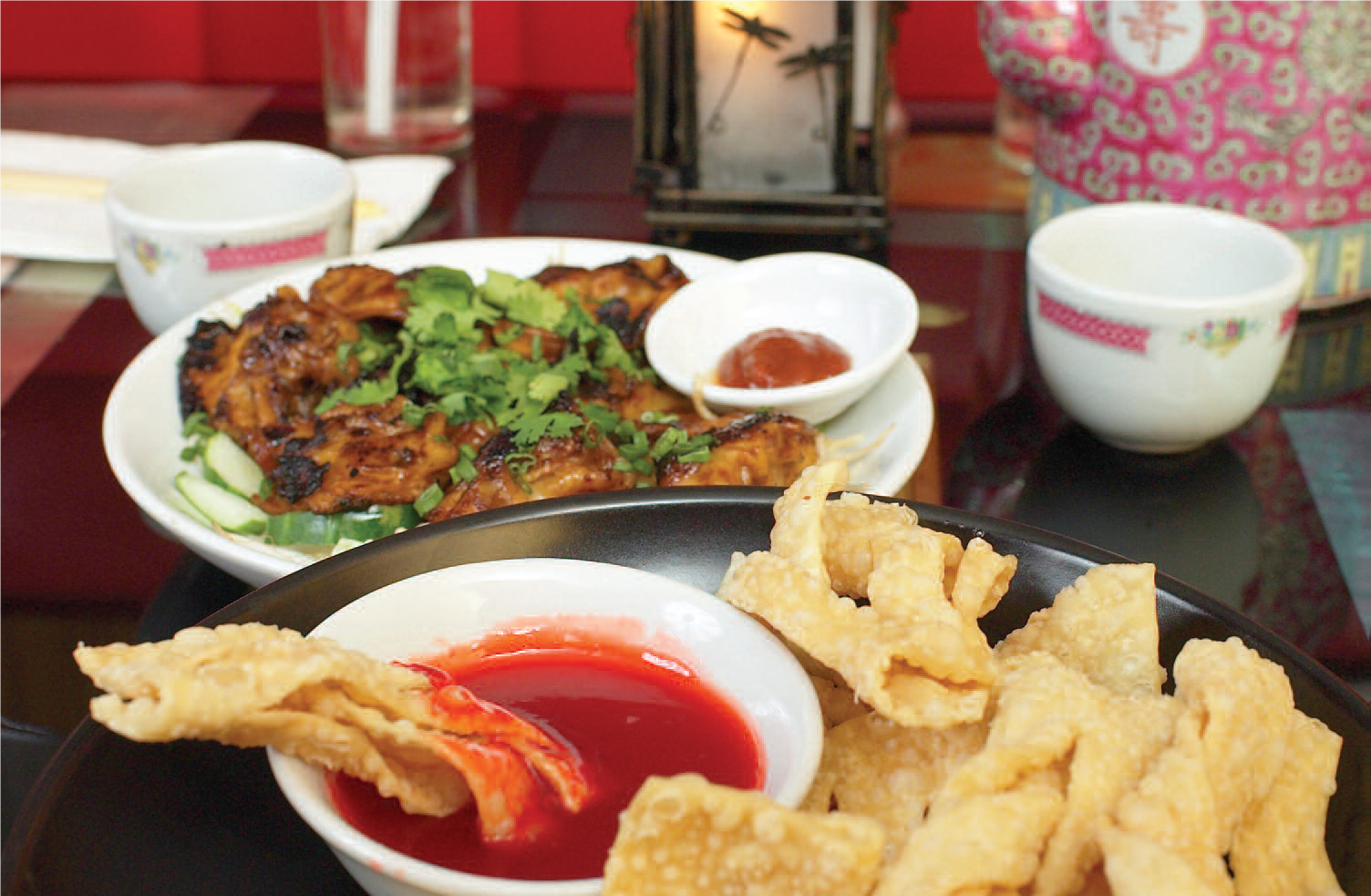Plates here arrive awash in subtlety, with sauces demure and focused, main elements expertly cooked, technically precise.

Photo credit: iStockphoto/Thinkstock

Photo credit: iStockphoto/Thinkstock
“Sam,” I say to my friend who is about to leave with his family on a trip abroad, “once upon a time in New Jersey, there wasn’t sushi on every corner or places nearby where you get tacos or tortas or other Mexican foods. There weren’t Thai restaurants. You know that, right?” Sam is 11 and, after hearing my spiel, puzzled. “Really, Andy?” he asks. “No California rolls?” I don’t want him to think I grew up deprived. But, compared to the variety of restaurant options we have today, the New Jersey I grew up in circa the 1960s and 1970s was, at best, limited. “When I was your age,” I tell Sam as we navigate the Garden State Parkway, “there was pizza and Chinese and that was about it for ethnic food.” I quickly realize I need to qualify Chinese. “I’m not talking Szechuan or soup dumplings or any of the things we eat now. Chinese was…well, Chinese was very different back then.” Which is why we are en route to Lun Wah, a classic in Roselle since 1974.
I wanted Sam to come back in time with me to a vintage New Jersey-style Cantonese/Polynesian restaurant, complete with tiki bar, waiters in Hawaiian-print shirts and a koi pond—a setting, a scene and a bill of fare almost extinct now in these parts. He’ll experience the most exotic foods of a generation past and realize what a treat it will be to have a chance to trek across the Atlantic to try a whole other new world of food. “Sam,” I continue as Steve Tyrell belts out Ain’t Misbehavin’ on my CD player, “you need to know how to take chances with new foods. You need to know how to order in a restaurant without falling back on the same-old, same-old stuff. You need to know this, Sam. You understand?” His response is barely audible, even though I’ve tamped down Tyrell. “Yeah,” he says. “When are we getting there?” We do get there, and settle into a bamboo-lined booth in one of two “palm”-tree lined dining spaces. Sam looks up at the fierce mask glaring down at us from its perch on the wall, then at me, unfazed. “How about Voodoo Steak?” I ask, and Sam laughs at the name. However, he’s appalled when I tell him we’re going to start with a pu-pu platter.” “Poo-poo? Oh, Andy, no!” Sam protests, until the platter arrives with a lazy-Susan arrangement of nibs and bits and a flaming mini-grill in the center.
Suddenly, Sam’s eyes glow. By the time we polish off our chunks of marinated beef, meaty hunks of ribs, shrimp toasts, packets of moist, spiced chicken and old-fashioned, pork-stuffed egg rolls, Sam is a big believer in the charms of Lun Wah’s superior pu-pu platter. Lun Wah is, after all, pure retro. As we spear cubes of beef, warming them for a minute on our grill, we see many diners file in. They’re all greeted by a veteran floor crew which seamlessly takes orders, delivers dishes and replenishes drinks served in pineapple shells trimmed with paper umbrellas and rimmed with plastic monkeys threatening to dive into the fruited spirits. By the time we’re served our resolutely Cantonese soups—a house wonton plumped not only with the steamed dough pouches filled with minced pork but also slices of chicken and roast pork, shrimp and crisp choy, and a thoroughly comforting chicken-corn that earned its moniker “velvet”—Sam’s ready to surrender to Lun Wah’s ways. “You can take the rest of the soup home,” I tell Sam, who is having a hard time saying goodbye to the kernels of corn and shreds of chicken swarming the not-too-thick soup base. This is a naturally thickened slow-cooked model, I suspect, for there is none of that cornstarch aftertaste that’s kept me from ordering the standard in many moons. Sam’s about to offer what I’m sure would’ve been a compelling argument for finishing every last drop of soup when our new best friend, Kenny—server sublime and master of Lun Wah ceremonies—arrives to see how we’re doing.
I take this as a cue our entrées are almost ready and, in turn, cue Sam to put down his spoon and prepare for more. “This place is the best, Andy,” Sam says, emphasizing the superlative with a slam-dunk imitation of one who has ingested a couple of Lun Wah’s Coco Locos, a concoction of rum and coconut milk. “What’s Volcano Steak?” Soon, he’s caught up on how he’ll describe to his family the multiple slabs of filet mignon set upon a thick layer of Chinese vegetables, all of which ring a tiny flame nestled in a citrus shell. Lun Wah doesn’t miss a chance to light a fire under, or for, its diners. But although there’s no shortage of ceremony and pomp, plates here arrive awash in subtlety, with sauces demure and focused, main elements expertly cooked, technically precise. The claypot subgum, a stew of myriad ingredients, illustrates that perfectly. There are chicken and shrimp, not a smidgen overcooked, shredded beef, muchos mushrooms and snow peas, broccoli and shards of more esoteric Asian vegetables in the heated pot. It’s bound by a light, sprightly sauce.
taste everything, individually. Nothing’s muddied. Grand Marnier shrimp, that luscious standard that at one time titillated, is textbook correct, with crunchy fried walnuts helping to offset the richness of the creamy, fruity sauce. Sam isn’t a shrimp fan (he’ll learn, he’ll learn), but he can’t get enough of that lush sauce, which he considers a kind of salad dressing for the thick slabs of cabbage and choy bedding the shrimp. We end as I always ended as a late-stage teen dining out with friends: with chocolate ice cream and chunks of pineapple.
On the way home, Sam, Lun-Wah-fortified, belts out his own personal rendition of “They All Laughed” and I don’t feel the need to reprise my beloved Steve Tyrell. But I do feel the need to reprise, for your sake, Lun Wah. So I return to check out several more classics that you might need to know about should you visit. Do you remember Happy Family? I remember Happy Family, and Lun Wah’s is a delirious version—the same that taught us about oyster sauce and how it relates to pork, shrimp, beef and chicken. Som Bo Duck is delicate and soothing, a splay of boneless duck breast amid chicken and shrimp, all atop a bevy of Asian vegetables. Coconut Shrimp never has been done as well in fusionfriendly New Age restaurants as it is here, with Lun Wah’s kitchen striking just the right balance of flakes to shellfish.
Just because we figured we should, we tried one of the handful of Szechuan selections, gingered beef that we asked to have kicked up to the max with hot sauce. The verdict? Gummy and one-dimensionally hot; no nuance, no finesse. Stick with Lun Wah’s core Cantonese/Polynesian dishes. Rather than doing dessert, use up your guilty-pleasure calorie allotment by starting your evening with one of the house-special drinks the folks gathering at the tiki bar so adore. Hawaiian Sunrise is a tart-tangy mix of lime juice and vodka. The Scorpion blends both light and dark rums with brandy, fruits and almond. Gin, lime juice and a liqueur (or two) we couldn’t divine and our server wouldn’t divulge make up the Bamboo Cooler. Lun Wah makes up in its warm wrap of nostalgia what it lacks in chic. There’s nothing new here. And there shouldn’t be. But when the call of the exotica of yore beckons, you’ll be glad to know it’s there, waiting for and welcoming baby boomers…and those whose generation has yet to be defined.






